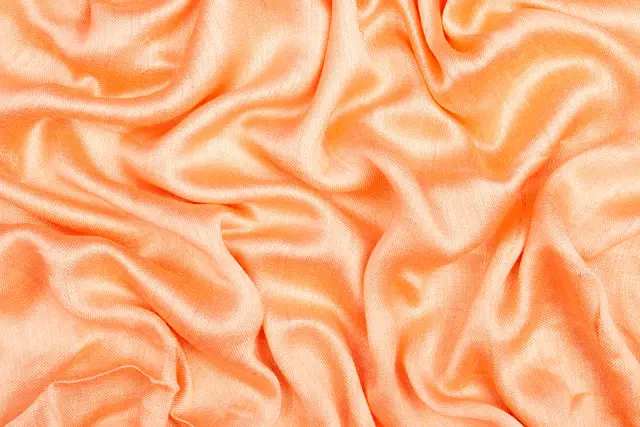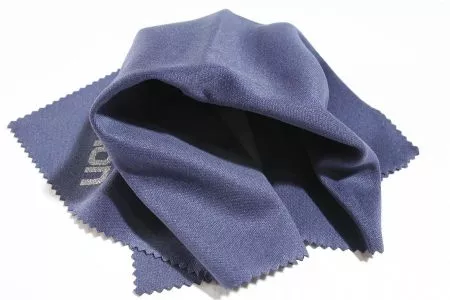To take good care of your garments, you must first understand the fabric used to make those garments. Unfortunately, we often wash our clothes without reading the tags, only to find that we have ruined the clothes by using the wrong settings to clean the clothes.
Yes, viscose does shrink. Viscose is a semi-synthetic fiber with both natural fiber and synthetic fiber characteristics. This fiber is delicate and can quickly shrink by; washing and drying it with a dryer, ironing especially when damp, immersing in water that is either warm or hot, and using a blow dryer.
Due to the fragile nature of viscose, the fabric is mainly blended with other fabrics and then used to make different clothing products. This article looks at whether viscose shrinks, how viscose shrinks, whether different blends shrink and how to unshrink viscose.
What Is Viscose?
Viscose is a semi-synthetic fabric. The fabric is 50% natural and 50% synthetic since it’s made from wood and plant and mixed with various chemicals to make viscose fabric. Some of the woods and plants that viscose is made from comprise pine, bamboo, soy, sugarcane, and spruce.
Viscose is made from 9 steps that are explained below:
- First, chips from different plants and wood used to make viscose are dissolved in various chemicals to make brown wood pulp.
- The brown wood pulp is then cleaned with caustic soda resulting in a raw material used to make the fabric.
- Rollers press the clean raw material to create pressed sheets.
- After the sheets have been pressed, they are shredded into crumbs.
- The crumbs are treated with chemicals to create a sticky solution.
- Sticky solution is filtered to get rid of any undissolved element.
- The solution is then degassed so that any air trapped in the solution is removed.
- The degassed solution is put in a machine that makes threads or yarns of regenerated cellulose.
- The ensuing cellulose fibers are spun into yarns and used to make viscose fabric.
Viscose has various strengths and weaknesses that make the fabric ideal for various garments.
Strengths Of Viscose
- It has high breathable value; hence it is commonly used for summer wear.
- It has a high absorption value and does not trap heat.
- It holds color for a long time without fading.
- It is easy to position and pin (drapes well).
- It is airy and light.
- Dries easily.
Weaknesses Of Viscose
- It quickly breaks apart, especially if washed with a machine.
- High shrinking value to the extent that it can shrink every time it is washed.
- It cannot withstand high temperatures as its quality declines when exposed to the sun.
- It is challenging to remove stains from viscose fabric.
- Highly vulnerable to mildew.
Due to the weaknesses of viscose, the fabric is commonly blended with other materials to make a better fabric. For example, when viscose is blended with cotton, the ensuing fabric is wearable, pleasing, and practical. The viscose silk blend also has an elegant silky look with high breathability values.
Likewise, when viscose is blended with linen, it produces a fabric that looks like linen yet has the drape of viscose.
Despite its disadvantages, viscose is loved for its expensive look, yet it is highly affordable. The fabric is commonly used as a blend, and it is used in making different types of clothing (such as pants, jumpsuits, tops, and skirts, among others), upholstery, and bedding products.
Viscose has been reported to be the third most popular textile fabric globally.
Why Does Viscose Shrink?
Viscose shrinks due to the nature of the fiber of the fabric. Specifically, viscose is synthetic, and as the fibers of viscose are made, they are not readied to be subjected to a lot of warm water (either from water or from any other source). Thus, viscose fabric shrinks as the fibers come into contact with heat from the warm water.
To better understand why viscose shrinks, it is essential to understand what makes all fabrics shrink.
Typically, there are three main reasons why fabric shrinks. The reasons are; the fiber make-up of the fabric, moisture, heat, and friction.
As far as fiber make-up is concerned, two types of fibers comprise natural and synthetic fibers. Natural fibers are susceptible to shrinking since when these fibers come into contact with high temperature and moisture, and the fibers are tightened, resulting in shrinking. However, synthetic fibers are not the case since they are heat resistant and will thus not shrink in normal temperature settings.
For moisture, a fabric that absorbs moisture shrinks because when the fibers take in water, they end up bulging, and this bulge makes the size of the fibers reduce, making the fabric shrink. But, again, this is because natural fibers take in moisture while synthetic fibers don’t.
In the case of heat and friction, when the fabric comes into contact with heat and also encounters friction, the heat and friction make fibers that are usually tightly woven to stretch out. As the fibers get back to their normal position, the fabric shrinks. Natural fibers have low heat-resistant values, while synthetic fibers are known to resist heat.
Considering the three reasons any fabric shrinks, viscose shrinks due to the nature of the fiber that makes up the fabric. This fiber is known to absorb water and have low heat resistance values. Thus, immediately viscose is in contact with warm water, it shrinks.
Viscose fabric is made from plant and wood pulp that is then converted to a fabric through chemical processes. For that reason, viscose is 50% natural and 50% synthetic. However, the fact that viscose is made from a chemical process means that the natural properties of viscose fibers decrease during the chemical process.
For example, when natural fibers are known to absorb a lot of water without any damage, viscose cannot do the same. Even if viscose absorbs a lot of water, the water that viscose absorbs damages the fabric. The cellulose structure has lost its water holding values during the chemical process of making viscose.
It is because when viscose becomes wet, it is highly prone to shrink, deform, or even tear. Also, because of that character, you have to be careful when washing and drying viscose so as not to damage it.
Does Viscose Fabric Shrink?
Yes, viscose does shrink. The fabric is 50% natural fiber and 50% synthetic fiber, thus making it susceptible to shrinking. Specifically, during the process of making the viscose fiber, the structure of the original material used to make the fiber is altered, making viscose shrink at ease.
Viscose can quickly shrink by washing it in a machine or drying it in a machine. Also, viscose can shrink by rinsing with warm water and drying it with a blow-dry. However, it is essential that when you are shrinking viscose, you take extra care since, as a fragile fabric, you could end up ruining it during the shrink process.
How Much Does Viscose Shrink?
To determine the extent to which viscose shrink, you first need to establish whether the viscose you have is 100% viscose or whether it is a blend of viscose and another fabric.
When you want to shrink viscose, first read the care tag on your garment and understand the fibers that have been used to make your fabric. Due to different viscose manufacturing processes, you can find that different viscose fabrics shrink differently.
If you have a fabric that is 100% viscose, the material can shrink up to 25% during the first wash when there is a lot of heat and agitation. Nevertheless, 100% viscose can shrink up to 8% in a normal situation.
If you have a viscose blend, viscose can shrink between 3%-5% in normal situations. Specifically, if the percentage of the natural fiber is higher than that of viscose in the blend, you can shrink your viscose fabric without damaging it successfully.
Does Viscose Shrink When Washed?
Yes, when viscose is washed, it can shrink. How you wash your viscose and the blend of viscose that you are washing are vital factors that will determine the shrink’s outcomes. If you want a small shrink, you will need to be more careful with how you wash the viscose garment to achieve a small shrink size.
Due to the characteristics of viscose, you will need to be very careful with how you wash and dry your viscose fabrics. Usually, if you are using a dryer to dry your viscose fabrics, you will need to be cautious since if viscose is left in the dryer for a long time, you will damage the material instead of shrinking it.
Since viscose is very fragile, you should make sure that you do not wash it regularly. From my experience with a viscose shirt, I found that dry cleaning is the best way to clean your viscose garments. Washing the viscose garment with a washing machine will eventually ruin your garment.
Does Viscose Shrink When Hand Washed?
Viscose does not shrink when hand washed. Therefore, it is recommended that you handwash your viscose garment and take good care of it. When washing any garment, you need first to read the tag on your garment to understand the best conditions to handwash your viscose fabric.
You should also note that even when hand washing viscose, you could shrink the fabric. For example, when handwashing viscose with warm water and you leave the fabric in the warm water for a long time, the fabric will shrink.
The way that you dry your viscose after handwashing will also determine whether the viscose will shrink or not. The fabric will shrink if you put your viscose in the dryer after hand washing it. If you hang it to dry in a position where it has direct contact with heat from the sun or other sources, your viscose will shrink.
To ensure viscose does not shrink after washing it, always make sure that you dry it on a flat surface. The surface should not be exposed to heat from the sun or other sources.
I prefer to wash all my viscose garments by hand as it is pretty easy and convenient, and I am always sure that I will not damage the garments.
Does Viscose Shrink In Cold Water?
Some of the common methods used to shrink most fabrics involve using washing machines, setting the hottest water temperature, putting the fabric in hot boiling water, and even using a hot iron.
The question of whether viscose shrinks in cold water can thus be answered with an emphatic no. In cold water, there is no heat that is needed to activate shrinking in any fabric. Therefore, if you wash viscose in cold water and hang dry it on a flat surface that does not have sunlight or any other heat source, the viscose cannot shrink.
As a matter of fact, when you want to wash your viscose fabric, it is always recommended that you either dry clean the material or wash it with cold water and a mild detergent. Washing viscose in cold water is ideal for washing viscose fabric as cold water cannot shrink the fabric.
When you wash viscose fabric in cold water, make sure that you have squeezed all the water in the fabric before hanging it to dry. If you hang the viscose fabric to dry with a lot of water, the fabric will stretch, which could ruin it.
Does Viscose Shrink In Dryer?
A dryer can shrink both natural and synthetic fibers. When you put clothes in the dryer, the heat inside the dryer and the agitation caused by tossing the garments around the dryer cause the clothes to shrink.
Viscose does shrink in the dryer since when you put viscose in a dryer, the heat from the dryer and the agitation of the fabric will shrink your viscose garment. If you first wash your viscose garment, the fabric will shrink during the washing, and if you want the fabric to shrink further, you can put it in the dryer for more shrinking after washing. However, your dryer needs to be set in the air dry mode.
When you want to shrink viscose with the dryer, you need to be very careful. First, the dryer’s heat needs to be set at the lowest temperature. In addition, the time that the garment stays in the dryer should not be more than 10 minutes.
Due to the delicate nature of viscose fabric, you should avoid putting it in the dryer if it is 100% viscose. When 100% viscose is loaded in the dryer, there is a high chance that you will damage the fabric. If you have a blend of viscose, read the care label first and shrink it in the dryer as per the instruction on the label.
Does Viscose 100% Shrink?
100% viscose is a fabric made of 100% viscose and does not have any other fiber in the material.
100% viscose will shrink either by washing it or by drying it. The best way to shrink viscose is by washing it with warm water and then hanging it to dry. The structure of the cellulose molecules that make up viscose is not very strong. If you subject your 100% viscose fabric to heat, you will damage the fabric.
To avoid viscose 100% shrinking, always hand-wash it in cold water and then dry it on a flat surface. Before drying the fabric, make sure that you have squeezed all the water from the fabric. You should also not hang viscose in a place where it will directly contact any heat. If damp viscose comes into contact with heat, it will shrink further.
Does Viscose Shrink With Every Wash?
Yes, whenever you wash viscose, the fabric shrinks. Moreover, even when you handwash viscose, the water that viscose absorbs during the cleaning process has a shrinking impact on the viscose fiber since it makes it weak.
To reduce shrink in viscose, you should always hand wash your viscose with cold water and a mild detergent. Any stains in the fabric should also be gently removed to avoid damaging the fabric.
It is also essential that you avoid drying viscose in the dryer since the dryer is likely to damage the viscose fabric unless you have a blend with a very high content of another natural fiber. You should always use the air dry or air fluff cycle whenever you dry viscose with a dryer.
How To Wash Viscose Without Shrinking?
Dry cleaning is ideal for washing your viscose garments without shrinking them. When dry cleaning, an organic solvent is used to clean the fabric, thus ensuring that the material will not be under high temperatures that make it shrink.
If you don’t want to take your viscose to the dry cleaners, you can be able to dry clean it with a tumble drier. In this case, you will need to use a home dry cleaning kit that can be bought at a local store.
Put the viscose fabric in the dry-cleaning bag, put at-home dry cleaning solvent in the dry-cleaning bag, and then put the bag in the tumble drier. Set the drier only air-dry setting, and when the cycle is over, your viscose fabric will be clean.
To dry the viscose fabric after you have washed it, just lay it on a flat surface or hang it on the clothesline.
The other method to wash viscose fabric without shrinking entails washing the fabric by hand. In this process, you will need cold water and a mild detergent. If your garment has stains, make sure that the stains are treated before you start handwashing.
To handwash viscose, put the garment in cold water and swish it until there are no bubbles in the washbasin. Drain the basin and refill with cold water to rinse. Softly squeeze water from the fabric and then lay it on a flat surface or a clothesline to dry.
You can also use a washing machine to clean a viscose without shrinking. First, however, you will need to place the viscose clothes in a mesh bag. Then, put gentle detergent in the washing machine and set cold water. The setting on your washing machine should be a handwash cycle and a slow spin speed.
| Detergent | Mild Detergent |
| Temperature of water | Coldwater temperature (About 68 F) |
| Type of cycle | Hand wash or gentle cycle |
| Dry | Air-dry the fabric |
| Ironing | Set the iron to medium heat or silk setting |
Does Viscose Blend Shrink?
A viscose blend can shrink. However, irrespective of the viscose content in the blend, your fabric will shrink since viscose is very fragile and shrinks at low temperatures, unlike other fabrics.
Viscose fibers are known to have minimal strength, and as such, they are not capable of withstanding warm heat from the water. Thus, immediately viscose comes into contact with small heat, the fabric shrinks.
Let’s now discuss whether different blends of viscose can shrink.
Does Linen Viscose Shrink?
A fabric with a blend of linen and viscose consists of two fibers with high shrinking values. Pure linen naturally shrinks when washed, while viscose is also the case. A blend of linen viscose will shrink at about 4%. If you want more shrinkage, you can shrink the fabric a couple of times.
If you don’t want your linen viscose to shrink, you should hand wash the fabric using cold water.
Does Viscose And Nylon Shrink?
Yes, viscose and nylon will shrink. Both fabrics are known to shrink, meaning that the blend will be easy to shrink. Usually, the viscose and nylon blend can shrink by washing, using a dryer, or even ironing the fabric.
You should also read the fabric’s care label with viscose and nylon blend. If the label indicates that the fabric is pre-washed, you might not be able to shrink it first, even though as you wash the fabric a couple of times, the pre-wash effect will decrease, making it easy to shrink the fabric.
Does Viscose Rayon Shrink?
Yes, viscose rayon shrinks. Both rayon and viscose are highly shrinkable. You can shrink the viscose rayon blend by washing the fabric in warm water. Take note that if you were to wash the fabric in hot water, you would ruin the garments.
If you do not want to shrink viscose rayon, you should always hand wash the fabric with cold water. Nevertheless, before you either shrink or wash viscose rayon fabric, it is essential that you first read the care label and make sure that you adhere to the instructions given.
Does Polyester Viscose Shrink?
Polyester is a synthetic fiber that is known to be resistant to shrinking. However, when subjected to a high temperature, polyester can shrink, even if that is never an easy process.
On the other hand, viscose shrinks even under warm temperatures. Thus, a blend of polyester viscose can shrink. To know the correct settings to use to shrink polyester viscose, you will need to read the care label on the garment.
You will find the exact percentages of each fiber in the fabric from the care label. If polyester content in the fabric is more than 70%, you will need high temperatures to shrink the fabric. If the viscose percentage is higher in the blend, warm water setting in the washing machine should be ideal for getting the fabric to shrink.
Does Viscose Rayon Shrink After Washing?
Yes, viscose rayon will shrink after washing unless the fabric is pre-washed. However, even if the fabric is pre-washed, it will only need a few washes, and then your fabric will shrink.
If you do not want your viscose rayon fabric to shrink, you will need to make sure that you wash the fabric with cold water and mild detergent. Moreover, you should also not put the fabric in the dryer. Instead, just let it dry on the clothesline and in a place where there is no direct sunlight.
Does 95 Viscose 5 Elastane Shrink?
95% viscose 5% elastane will shrink. These two fibers are synthetic. The manufacturing process of the two fibers creates tension among the fibers, and as the fibers come in contact with heat, they relax, making them shrink.
Since the viscose percentage in the blend is 95%, you will not need high temperatures to shrink this blend. However, washing the fabric at a warm temperature and using an iron set at warm temperatures will shrink the fabric.
Does Viscose 80 Shrink?
Yes, viscose 80 shrinks. The fabric has 80% of viscose, and as a result, this garment can shrink irrespective of the other 20% of the blend. In addition, viscose usually shrinks under warm temperatures, so viscose 80 will shrink.
To shrink viscose 80, you can wash the garment in warm water. However, if you use hot water, you should be careful as you could damage your fabric.
Can Viscose Shrink More Than Once?
Yes, viscose can shrink more than once since every time you wash viscose, there is a chance of the fabric shrinking.
If you don’t want your viscose garment to shrink a lot, you can avoid washing the garment regularly. In addition, when you wash the garment, make sure that you only hand wash it with cold water or just dry-clean it.
If your viscose garment reads that the garment is pre-shrink, the garment might not shrink during the first few washes. However, as you wash the garment a few times, the pre-shrink property of the garment will lose its effect, meaning that you will be able to shrink it.
If you want to shrink viscose many times, you need to be extra careful since the more you shrink your garment, the higher the chances that the garment will be ruined.
To take good care of your viscose garment, make sure that you always avoid shrinking the garment. If you have to shrink it, do it only a few times and after a long interval.
How To Shrink Viscose Top, Shirt, Dress
For most garments, it is common to shrink them with a washing machine, dryers, hot water, and cloth iron. Nevertheless, when you want to shrink a viscose shirt, top, dress, or any other piece of clothing that has viscose, you should not use methods commonly used to shrink other fabrics.
Here are the steps you should use to shrink your viscose
- Prepare warm water that you will use to soak the viscose fabric in.
- Immerse the fabric in warm water and make sure that it is fully immersed.
- Leave the viscose fabric in warm water for about three hours.
- After three hours, take the fabric out of the water.
- Drain all the water in the fabric by gently squeezing it when placed between two towels.
- Dry the viscose fabric by placing it on a flat surface.
- Iron your garment with the iron set in a warm setting.
- If you still need the garment to shrink further, repeat the process a few times.
How To Unshrink Viscose
After shrinking your viscose, you might realize that the viscose has shrunk too much. You can try to unshrink your fabric. However, if the fabric has shrunk too much, it might be impossible to get your fabric back to its original size.
Here is a simple process you could use to unshrink your viscose fabrics:
- Put a fabric softener in a washbasin and mix it with water. A hair conditioner or even shampoo can be used as a conditioner in this case. If you don’t have a softener, wait till you get one since the softener plays a significant role in making the fabric fibers loose. If you attempt to unshrink without the softener, you could ruin the fabric.
- Put the fabric you want to unshrink in the water and softener solution. First, you must make sure your material is immersed in the solution.
- Leave the viscose fabric in water and softener solution for five minutes.
- Take the fabric out of the solution and place the garment between two towels (one on the top and the other one on the bottom).
- Gently squeeze the fabric that is between the towels to dry it.
- Place the fabric on top of another towel placed on a flat surface.
- Beginning from the center, you will slowly pull the viscose fabric and stretch it. Make sure that you slowly pull it since if you pull hard, you could end up tearing the fabric.
- After you have pulled the garment to the size you want, you can now leave it to dry on a flat surface.
Final Thoughts!
Viscose is an excellent fabric with an elegant look yet affordable to many. To take good care of your viscose garments, you should avoid washing the garments regularly.
If you have to wash the garments, you can dry-clean them instead of washing them with water. Alternatively, you can handwash the fabrics and use cold water with gentle detergent. To shrink viscose, you only need warm water and follow the steps I have outlined in the article.
Source
Tobin, A. (2021). What is Viscose – SupplyCompass Material Guide.







